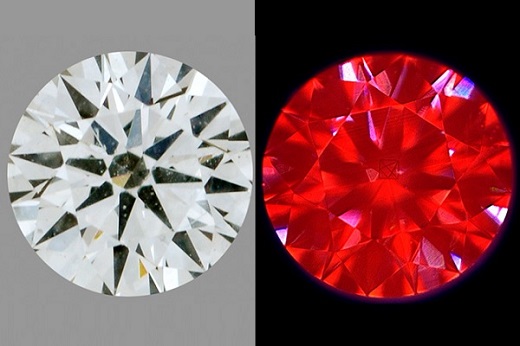|
|
GIA Sheds Light on De Beers’ Synthetics
Feb 7, 2019 9:58 AM
By Joshua Freedman
|
|
|

RAPAPORT... Two white lab-grown diamonds from De Beers’ Lightbox brand
have G color and VS clarity, the Gemological Institute of America (GIA) said
after examining the stones.
Lightbox doesn’t offer grading reports for its products, and
hadn’t previously publicized their specific quality characteristics. The GIA
obtained the 0.24-carat and 0.26-carat polished stones from a “third-party
vendor,” according to Sally Eaton-Magaña, a senior research scientist at GIA in
Carlsbad, who published her findings in the Winter 2018 issue of the institute’s quarterly journal, Gems & Gemology.
Both stones — intended for a pair of earrings — would have
had VVS clarity had the Lightbox logo inscription not reduced their grades to
VS, Eaton-Magaña observed. The smaller stone had Excellent cut, while the
larger one was considered Very Good.
“These samples [published by the GIA] are consistent with
our expectations,” Sally Morrison, Lightbox’s chief marketing officer, told
Rapaport News Wednesday. The brand occasionally tests some of its stones to
ensure they fall within a predictable range, even though it doesn’t provide the
grading information to consumers, Morrison added.
No HPHT treatment
The stones showed no sign of color treatment, unlike many other
chemical vapor deposition (CVD) diamonds, the GIA reported. Most producers grow
CVD layers quickly, leaving a brown color, knowing they can improve them later
with High Pressure-High Temperature
(HPHT), Eaton-Magaña explained. For that reason, about 75% of the CVD material
in this color range that the GIA has examined to date had been through HPHT treatment
following growth, she noted.
“Other manufacturers with less advanced technology may well
have to use HPHT treatments to make the color quality acceptable, but we don’t
need to do this,” Lightbox’s Morrison confirmed. “Like any manufacturing
process, a small fraction of our stones do fail to meet our rigorous quality criteria.
These stones are simply rejected, and we don’t sell them.”
De Beers has previously claimed that its decades of
investment in synthetic diamonds have enabled it to offer Lightbox jewelry at the
relatively low retail price of $800 per carat. One factor in that is its capacity
to grow diamonds with good-enough color to sell untreated, Morrison indicated
Wednesday.
“All HPHT treatments really do is add cost and complexity to
the manufacturing process,” she said. “This may in part explain why some
other lab-grown-diamond manufacturers charge higher prices than Lightbox.”
The company has no problem with other producers
HPHT-treating their own synthetic diamonds, even without disclosure, Morrison
argued. “This is already a manufactured product, and it really doesn’t matter
how many stages there are to the manufacturing process,” she said.
Clearly lab-grown
The stones were easily detectable as lab-grown, not just
because of the Lightbox mark. Under spectroscopic analysis, they had very
similar features to other CVD diamonds the GIA had previously tested,
Eaton-Magaña said.
Lightbox’s blue and pink stones — which form a large
proportion of its product range but weren’t part of the GIA’s sample — are also
readily identifiable as synthetic because they look significantly different
from the equivalent natural diamonds, the scientist added.
“Since natural diamonds and lab-grown diamonds are two
different products, there would be no reason for us to set out to mimic natural
colors,” Morrison explained. “Instead, the pale-pink and baby-blue colors were
selected for our initial launch based upon consumer research. We tested a
range of colors, but most consumers in focus groups definitively preferred the
pastel shades that we are currently manufacturing.”
GIA rethinks its reports
The GIA’s findings raise an issue about how it grades
synthetics, with the institute revealing it’s considering changes to its system.
Though Eaton-Magaña said the Lightbox stones were equivalent to G color, the
GIA doesn’t currently offer such detail in its grading reports for white
lab-grown diamonds, providing only loose terms ranging from colorless (the top
grade) to light (the lowest). Additionally, its clarity descriptions for
synthetics don’t break down VVS, VS, SI or I into any subcategories.
Plus, the name of the GIA document, “Synthetic Diamond
Grading Report,” hasn’t always gone down well. Diamond Foundry, a large
lab-grown producer, called on the institute to rethink its reports last year
after the US Federal Trade Commission (FTC) removed “synthetic” from its list
of recommended descriptors for lab-grown diamonds, and edited “natural” out of
its definition of diamonds.
“In the very near future, GIA will finalize and announce
changes to our reports for laboratory-grown diamonds to align with the FTC
guides and changes in the market,” Stephen Morisseau, the GIA’s director of
corporate communications, said in a statement to Rapaport News
Wednesday.
Image: The 0.26-carat lab-grown Lightbox diamond (left), and as seen through DiamondView imaging technology, with the inscription visible (right). (Robison McMurtry/Sally Eaton-Magaña/GIA)
|
|
|
|
|
|
|
|
|
|
Tags:
De Beers, federal trade commission, ftc, Gemological Institute of America, gems & gemology, GIA, High Pressure-High Temperature, HPHT, HPHT treatment, Joshua Freedman, Lightbox, Rapaport News, Sally Eaton-Magaña, sally morrison, Stephen Morisseau, Synthetic Diamond Grading Report, Synthetics
|
|
|
|
|
|
|
|
|
|
|

|
|